While standing plants are fine, if you really want to give your home that ‘Nature-kissed’ look then you’re going to need hanging plants too.
Thankfully, there are a number of beautiful plants that are not only well-suited for that purpose, but which are also very low-maintenance so that you can spend time admiring them, instead of spending all your time tending to them.
We’ve got a little something for everyone here, so take a look and see which ones pique your interest. Let’s take a look at the 25 best indoor hanging plants for inviting nature’s enchantments into your home!
Indoor Hanging Plants to Consider – Our Top Picks
- Brasil Philodendron – Philodendron hederaceum
- Little Swiss Monstera – Monstera adansonii
- Spider Plant – Chlorophytum comosum
- Happy Leaf Pothos – Epipremnum aureum Manjula
- Beetle Peperomia – Peperomia quadrangularis
- String of Hearts – Ceropegia woodii
- Lace Flower – Alsobia Dianthiflora
- Devil’s Ivy – Epipremnum pinnatum ‘Aureum’
- Strawberry Begonia – Saxifraga stolonifera
- Forest Cactus – Lepismium bolivianum
- Donkey’s tail – Sedum morganianum
- Spiderwort Nanouk – Tradescantia albiflora
- Air plants – Tillandsia family
- Ice Cascade Cymbidium – Cymbidium Sarah Jean ‘Ice Cascade’
- Morning Glory – Ipomoea purpurea
- Cebu Blue Pothos – Epipremnum Pinnatum ‘Cebu blue’
- Grape Ivy – Cissus rhombifolia
- Christmas Cactus – Schlumbergera truncata
- Sterling Silver – Scindapsus Treubii Moonlight
- Polka Dot plant – Begonia Maculata
- String of Beads – Senecio rowleyanus
- Hindu Rope Plant – Hoya carnosa ‘Compacta’
- Bird’s Nest Fern – Asplenium nidus
- English Ivy – Hedera helix
- Prayer Plant – Maranta leuconeura
Brasil Philodendron – Philodendron hederaceum
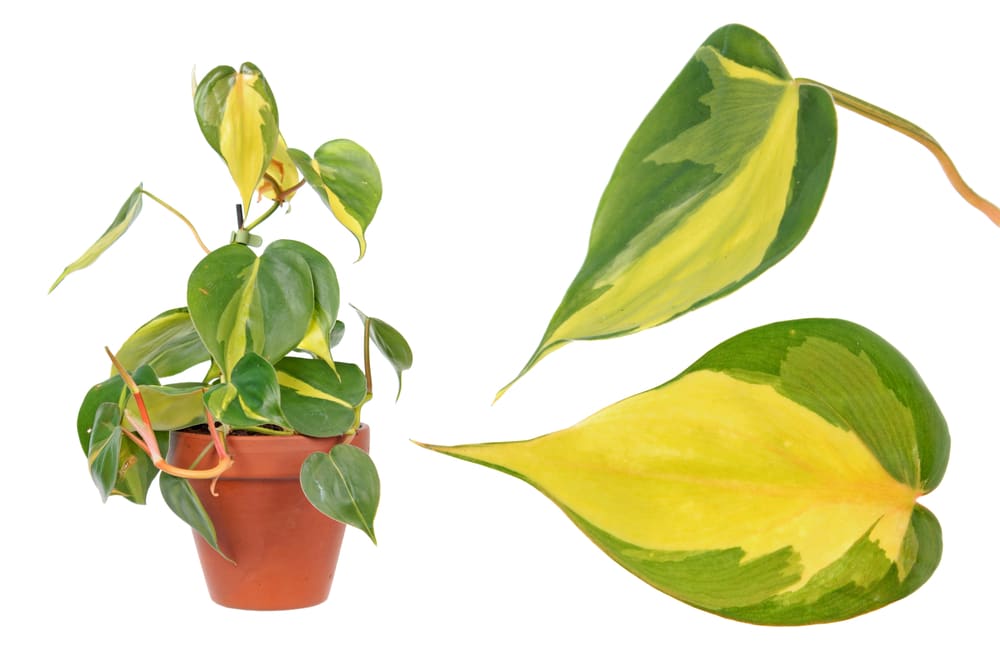
The Brasil Philodendron is a great hanging plant in that it looks beautiful and it’s very hard to kill – perfect for beginners or those who don’t spend as much time at home due to work or an active social life. These plants look great in a hanging basket, with their leaves being predominantly dark green with interspersions of gold and chartreuse hues to keep things spicy.
They also stay pretty manageable size-wise, with a top height and width of 36 inches each way.
Brasil Philodendrons should be potted in a mix of 1 part regular potting soil, 1 part perlite, and 1 part peat moss for best results. While these plants will survive in low light, they’ll do much better in indirect medium or bright light – just keep them out of direct sunlight or they will burn.
As far as water, make sure that the top half of the soil is dry and if so, then it’s ready for watering. This generally equates to watering one a week in the warmer months and a little less frequently in the winter.
Little Swiss Monstera – Monstera adansonii
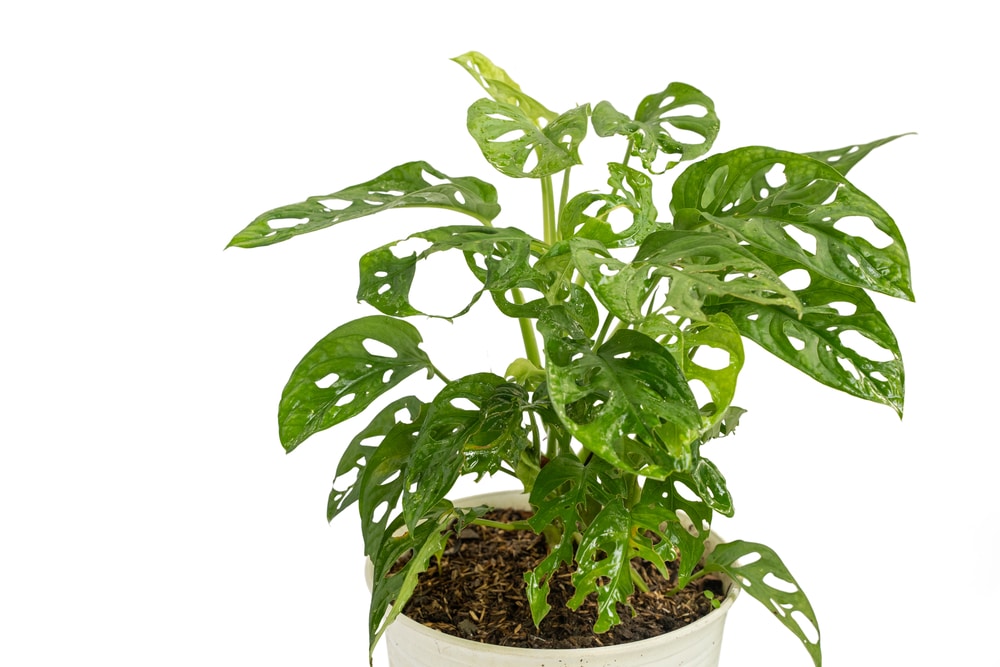
Ever seen a Swiss-cheese plant?! The Little Swiss Monstera is quite the character, with holes naturally occurring in it’s leaves just like a piece of Swiss cheese. This makes it a delight to look at it, both from the plant and for the shadows that it casts from time to time.
The Little Swiss Monstera grows quickly, about 2 feet every year to a maximum height of 13 feet, so you can hang it but keep in mind that eventually you’ll want to move it into a corner.
This tropical plant will do fine in regular potting soil, but you should add some peat and it will really thrive. It needs a lot of sunlight, about 6 hours of bright, indirect light, and watering should be done every 1 to 2 weeks when the soil has been allowed to completely dry.
Spider Plant – Chlorophytum comosum
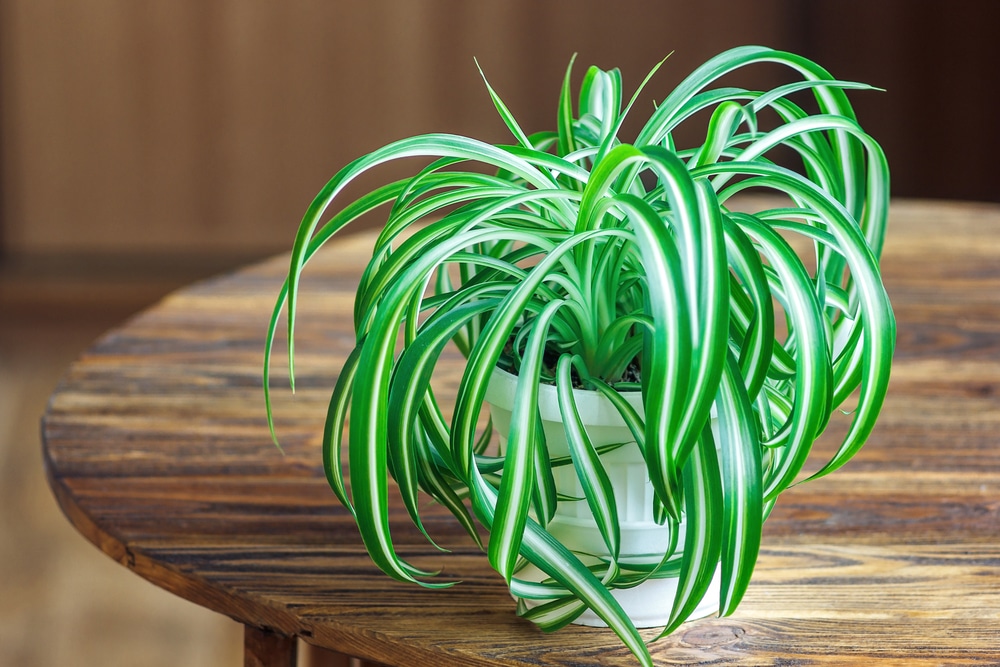
With it’s long, bladelike leaves of dark green or green mixed with a creamy white, the Spider plant is another popular choice for hanging in your household. Especially when you consider that the leaves produce tiny offspring that you can pluck off to plant on their own to get more free Spider plants!
Your spider plant should be about 12 – 15 inches tall at full maturity, with an overall length of around 3 feet, and those babies we mentioned will start off as white flowers in the spring… keep an eye out for them, they’re quite pretty!
Regular potting soiled placed over a base of peat moss or orchid bark is optimal and bright, indirect sunlight is best. Check that the top 2 inches of soil are dry before watering and you’re optimal watering rate should come out to around once every week.
Happy Leaf Pothos – Epipremnum aureum Manjula
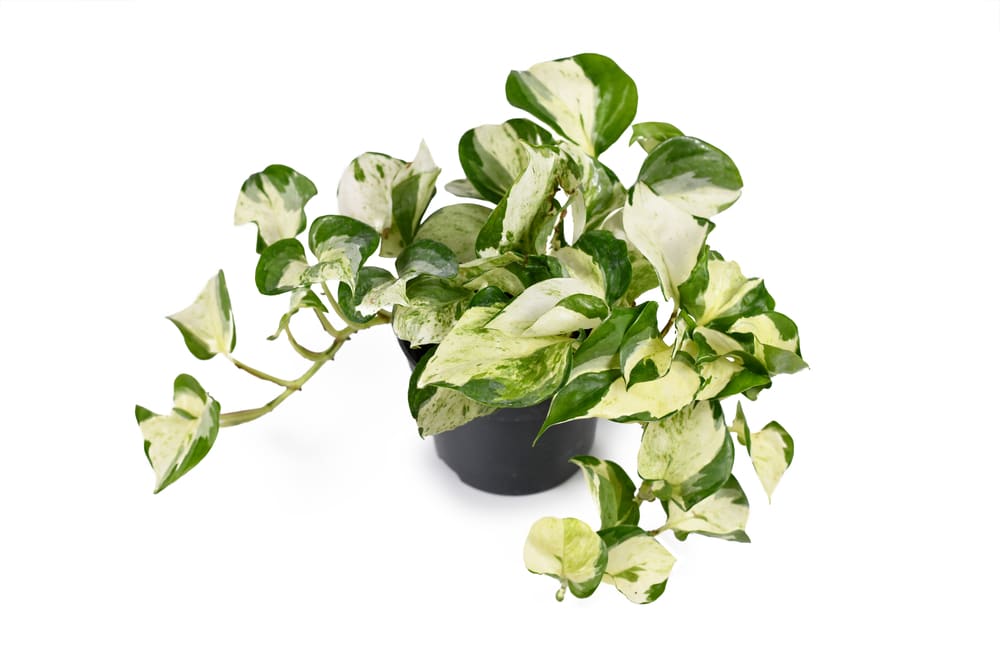
The Happy Leaf Pothos is a good-looking hanging plant that sports light green, almost creamy-colored leaves. While they get pretty big in the wild, in your home the vines can get up to 24 feet in length, with leave measuring in at 4 – 8 inches long. A little pruning from time to time will let you show off this hanging plant without letting it go too crazy.
You want good drainage in the soil, so pot your Pothos in regular potting soil mixed with perlite. While low-light will be tolerated, bright and indirect light is best for this plant and you should expect to water it every 5 – 7 days – provided that the top 2 inches of the soil have already dried out.
Beetle Peperomia – Peperomia quadrangularis
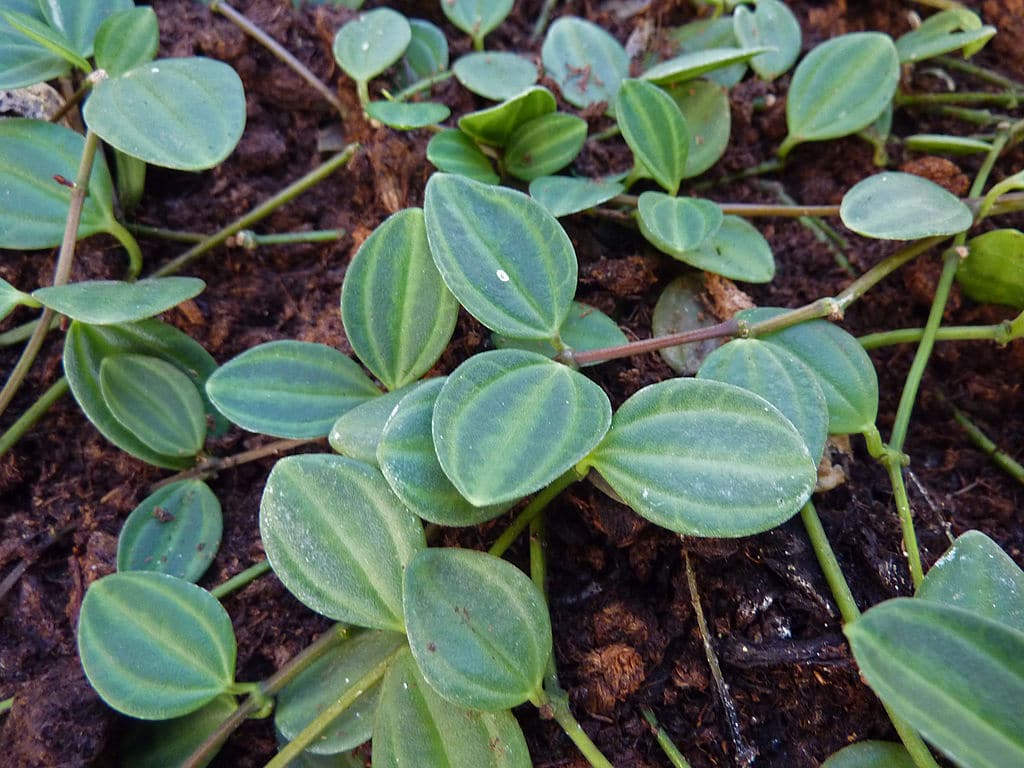
The Beetle Peperomia is a lovely choice for hanging in your house, with a simple beauty to it and low care requirements. The leaves of the plant have a waxy, leathering look, with a lighter and veined green hue for the leaves and it is also quite compact – you won’t have to worry about eventually making it ground-bound.
Beetle Peperomias have a fully-mature height of about 12 inches – quite manageable indeed!
Regular potting soil will work for your Beetle Peperomia, provided that you mix in some perlite for improved drainage, and it need bright, indirect sunlight to stay healthy and keep it’s leaves colorful. These plants are sensitive to overwatering, so water it only once a week and only then if the top 2 inches of soil are dry.
String of Hearts – Ceropegia woodii
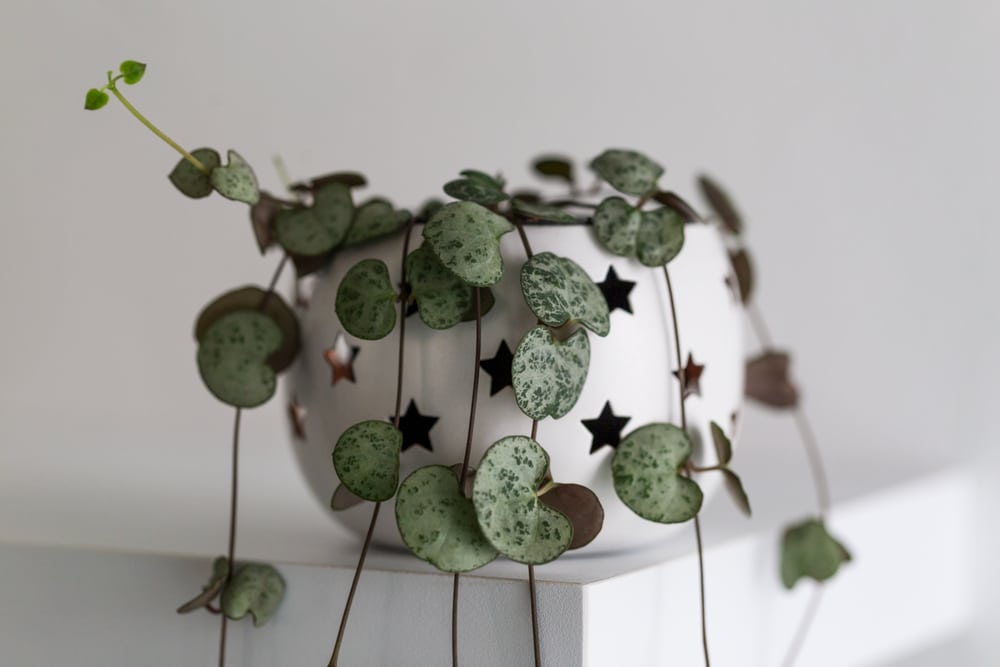
The String of Hearts is a real looker, with green, heart-shaped leaves that feature silver veining in the variety that we’ve chosen today. The hearts hang down from your hanging planter quite attractively and this makes the String of Hearts an excellent choice for a well-trafficked area of the home.
The vines of this plant are quite manageable as well, reaching a mature length of 2 to 3 feet on average.
This plant comes from Africa and is close enough to a succulent that succulent soil mix is a perfect fit. Give it bright, indirect sunlight and keep it out of sunbeams – direct light may burn the leaves. Making sure that the soil is completely dried out first, you’ll likely find that you need to water this plant once every 2 weeks in the warmer months and every 3 to 4 weeks in the wintertime.
Lace Flower – Alsobia Dianthiflora
If you like a lot of flowers when it comes to your houseplants, then Lace Flowers are a good choice. These plants have lovely and fuzzy green leaves and when spring arrives, you’ll get a delightful array os snowflake-like white flowers.
Alsobia Lace Flower plants have a fully mature height of about 12 inches, so if you want a plant that’s both pretty and practical then this is an excellent choice for hanging.
African Violet potting mix is an ideal soil for Lace Flowers and bright, indirect light is best. If the flowers get yellow on you, move it further away as this is a sign of too much sunlight. Let the soil dry out before watering, and water is once a week on average, and a little less frequently in autumn and winter (approximately once every 8 to 10 days, just check the soil).
The only exception is when it is flowering, at which time every 3 days is ideal for watering. For best results and optimal growth, water soluble fertilizer every 3 months is a good idea.
Devil’s Ivy – Epipremnum pinnatum ‘Aureum’
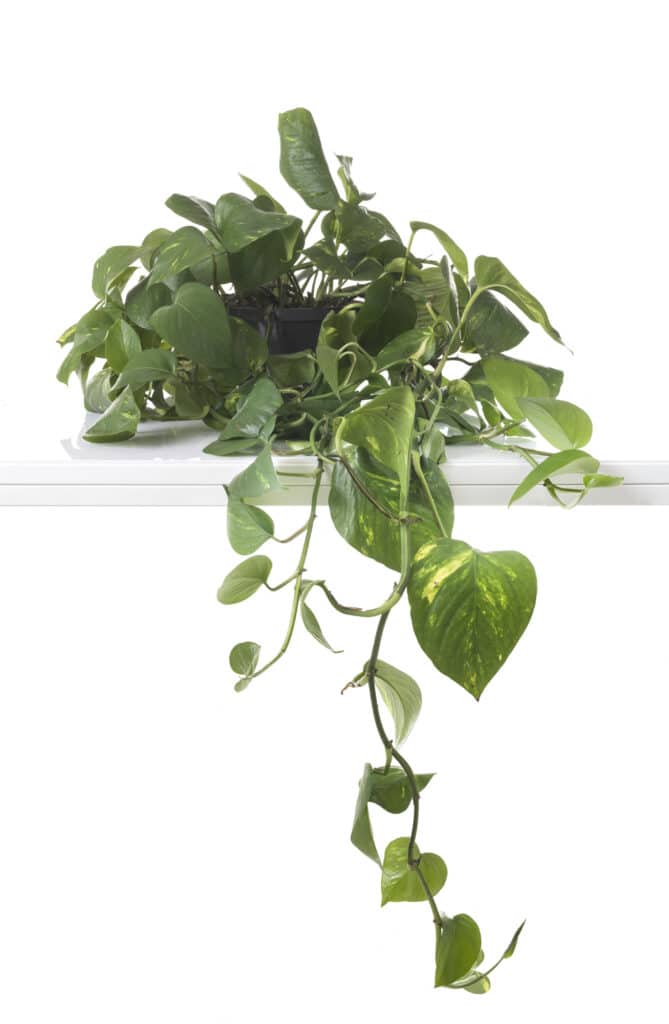
Devil’s Ivy is another variety of Pothos that is both hardy and attractive. It has green leaves, with touches of yellow, and in the wild it is quite the climber. Left in a hanging pot, however, those pretty leaves will dangle down and you’ll need to trim the vines from time to time – Devil’s Ivy can reach lengths of up to 40 feet unchecked!
Regular potting soil with a little coco peat or regular peat moss will be porous enough of a soil matrix to grow your Devil’s Ivy properly. Bright, indirect sunlight is also best for this plant, which will tolerate low light but you’ll lose that extra yellow on the green leaves.
As far as water, check the top 2 inches of the soil and if it’s dry, then it’s watering time – this will usually mean watering once a week, but always check to be on the safge side.
Strawberry Begonia – Saxifraga stolonifera
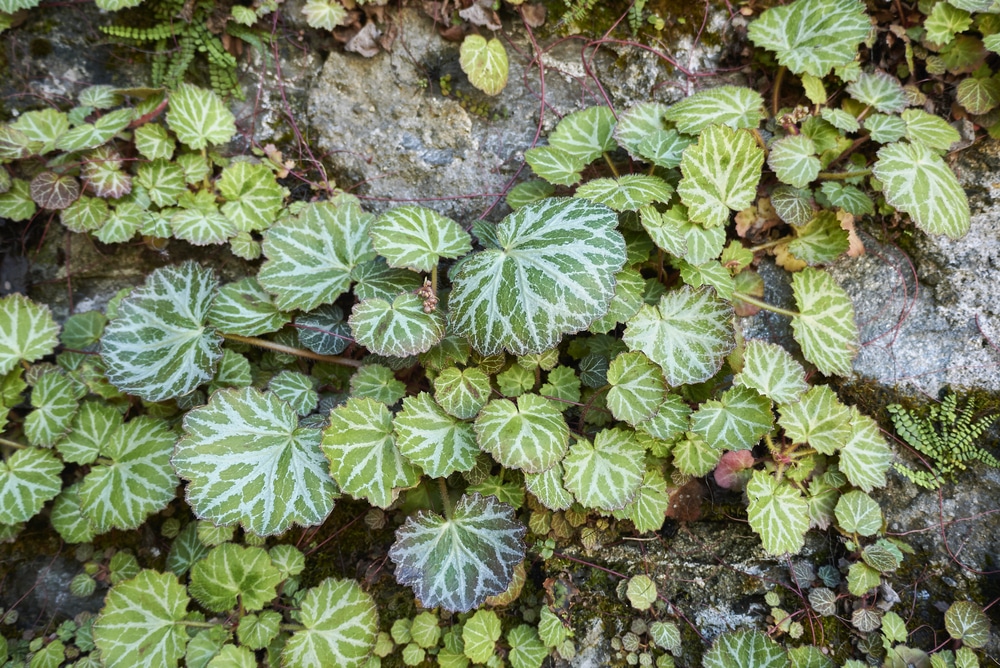
The Strawberry Begonia gets its name from a neat little trick that it performs for you every spring. During this time, you’ll see little red stolons nestled in the leaves, much the same as with a strawberry plant, and if you clip these then you can quickly pot them and have another plant!
Despite their prolific propagation, they are quite manageable in size, ranging from 6 to 18 inches tall and only 12 – 24 inches wide.
Regular potting soil with a dash of peat for good drainage is the best choice for your Strawberry Begonias and give them lots of bright, indirect sunlight for optimal growth. Water infrequently but don’t let the soil dry out, with an optimal frequency being about once every week for your Begonias.
Forest Cactus – Lepismium bolivianum
While it looks a little like a thin-leaved Spider plant, the Forest Cactus is something that’s just a little stranger. It’s a spineless cactus that produced numerous long, beautiful green strands that tempt one to paint cute little eyes on the pot.
Once your plant matures, then you get some bonus color in the form of summer rosette-shaped flowers, either pink or white, that will pop up like magic to brighten your day. At full maturity, expect a length of about 3 feet on the vines, but keep in mind that the flowers will take a while – this plant isn’t fully matured for about 8 years. When it happens though, it will be like a birthday present that you definitely weren’t expecting!
Cactus mix potting soil is perfect for this plant and bright, indirect sunlight is best. Let the top half of the soil dry out between waterings and this will generally mean you’ll be giving it water once a week in the warm months, once every 10 days to 2 weeks in the winter.
Donkey’s tail – Sedum morganianum

With it’s pale-green and somewhat alien clusters, the Donkey’s tail succulent is sure to get your attention and it definitely spices up a space. It’s also quite easy to maintain, like most succulents, and that’s always a bonus when you’ve got a lot of nature inside your home to take care of.
While they start off small and cute, this is a plant that will grow to fill some space, with a maximum length of about 4 feet when fully mature, with a width of about 2 feet at the most.
Sandy soil makes your Donkey’s tail the happiest, so give it some cactus mix and it should be a perfect fit. At least 4 hours of bright, indirect light is necessary for this plant and some prefer to give direct sunlight for the morning hours. Be careful if you do, however, as it can burn from this so indirect light is the recommended option.
The watering is the best part of this plant, as these babies are drought-resistant, so let the soil dry out and simply water it once a month and your Donkey’s Tail will be happy and healthy.
Spiderwort Nanouk – Tradescantia albiflora
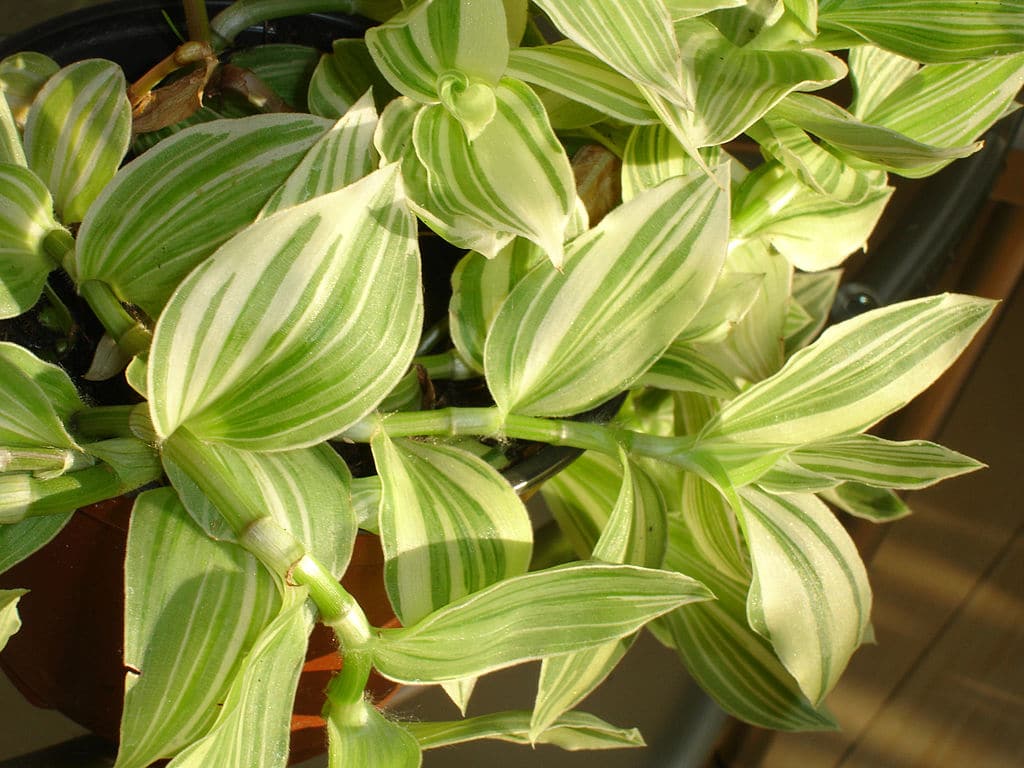
Spiderwort Nanouk looks quite amazing once it’s had a chance to grow a little. This is because it produces large leaves which are green but also pink and cream, or sometimes even with a little purple! This makes them a great choice for a table or a hanger and a perfect corner-filling plant – at full maturity, those dangling stems can be up to 6 feet in length and about 2 feet overall width for the plant.
Regular potting soil is fine, just be sure to add a little perlite for improve drainage, and bright sunlight is best – either direct or indirect is fine. Watering is easy, just check the top inch of the soil to see if it’s dry, and if it is then water it. You’ll probably have a frequency of once a week.
Air plants – Tillandsia family
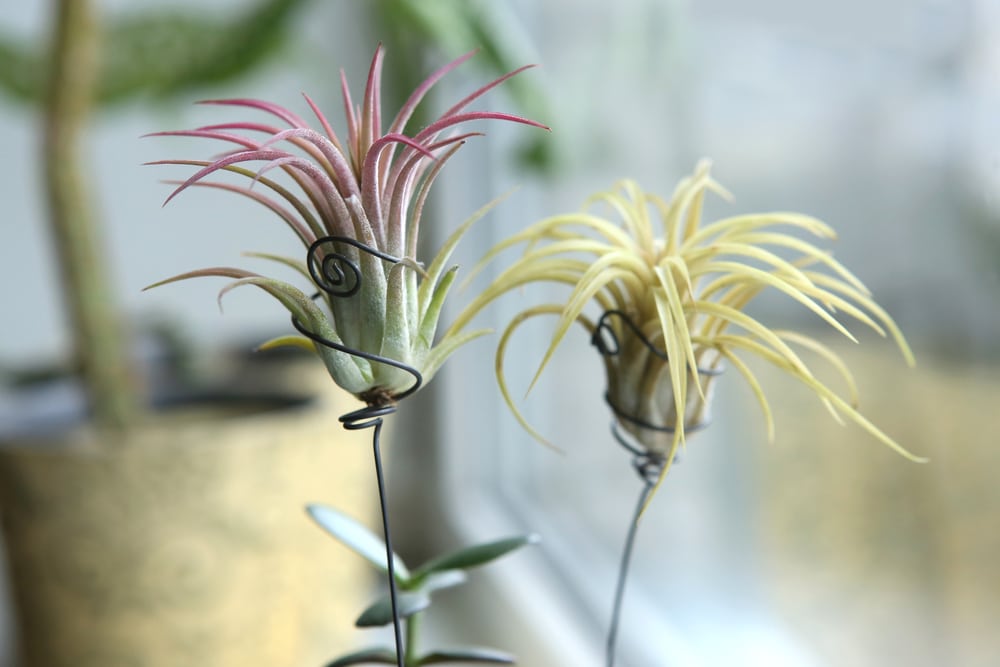
With over 500 different species and a number of colors such as vibrant reds, hot pinks, bright purples, and rich yellows, Air plants give you a lot of options and require very little care in exchange. You don’t need soil for these, so you’ve also got the most options when it comes to hanging.
Air plants might be displayed in delicate globes of glass, kept inside an ornate mesh cage, or even living on a refrigerator magnet – it’ll grow just about anywhere.
To care for it, mist it twice a week (or daily if you like) and every 2 – 3 weeks give it a 2-hour soak in water and bright, indirect sunlight is going to be best. That said, if you really want an exotic look and you’ve got a bathroom window that brings in some sunlight, these are great plants to put all over the bathroom. The humidity from your showers keeps them happy and the overall look is something that needs to be seen to be believed!
Ice Cascade Cymbidium – Cymbidium Sarah Jean ‘Ice Cascade’
While we don’t tend to think of orchids as hanging plants, the Ice Cascade Cymbidium is a definite exception. With long, spiky leaves and beautiful white, hanging flowers, it’s an attractive choice that you are sure to enjoy for many, many years.
These plants will bud in the winter and should bloom from May through September, but they will need to be well-watered and fertilized (more on this shortly) and the temperature must range between 55 and 73 degrees!
Ice Cascades will grow to be up to 24 inches tall and 24 inches wide, making them ample enough for a humble space without looking too ‘bulky’.
Paphiopedilum orchid mix is perfect for these plants and they require lots of bright, indirect sunlight. For watering, every 7 to 10 days is ideal, just check to make sure that the top inch of soil is dry.
Morning Glory – Ipomoea purpurea
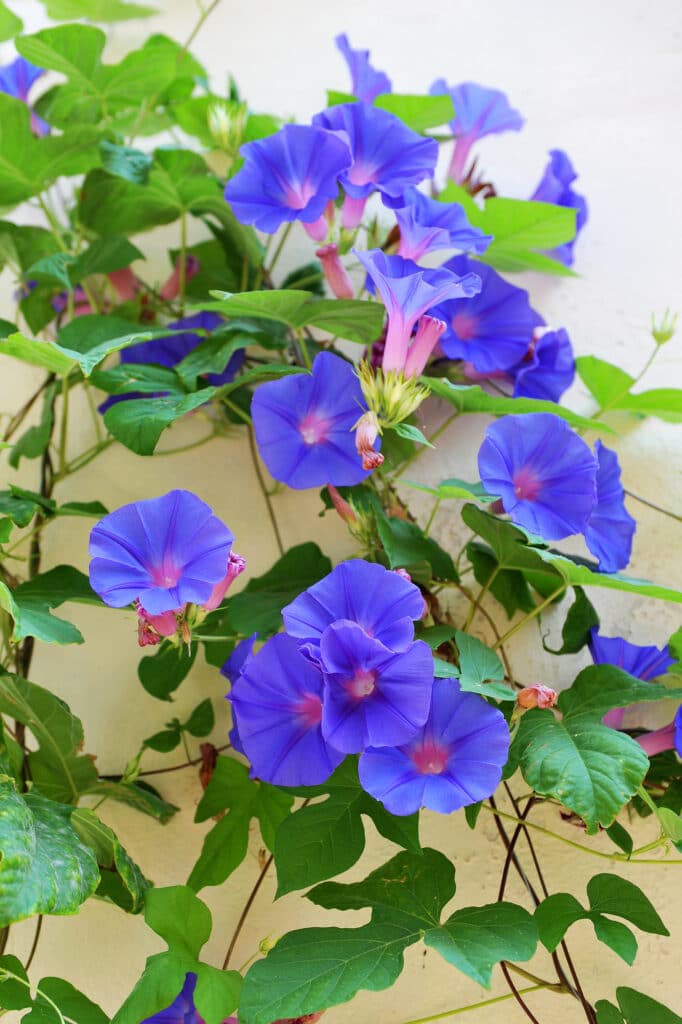
Morning Glories are actually quite a good fit for hanging planters as they look amazing and they are quite easy to grow. The variety we’ve chosen here has beautiful green vines and purple flowers, but another popular choice to look for is ‘Heavenly Blue’.
You’ll want to trim is from time to time, but the maximum length of Morning Glories is just under 10 feet.
Morning Glories aren’t very picky about their soil, so regular potting soil with a little perlite or even simply some gravel at the bottom to facilitate drainage will do perfectly well. Full, direct sunlight is best for these plants and twice a week watering is ideal with all of that direct sunlight that they will be getting.,
Cebu Blue Pothos – Epipremnum Pinnatum ‘Cebu blue’
Native to the Philippine Island of Cebu, these beautiful plants have been grown around the world, and are now found in the wild all over Asia and in South America, too. It’s easy to see why, as they have a silver-blue look to them that sometimes borders on turquoise.
In the wild, they can reach lengths of up to 40 feet, but with a bit of trimming you can keep them under control in your home. Just keep in mind that they’ll probably grow a few feet every summer if you take good care of them.
While regular potting soil will work, you really should consider adding a little perlite at the bottom or some orchid bark to make your Cebu Blue feel at home. As far as sunlight, about 6 hours of bright, indirect light every day is best, and watering weekly should be quite enough to keep your plant happy.
Grape Ivy – Cissus rhombifolia
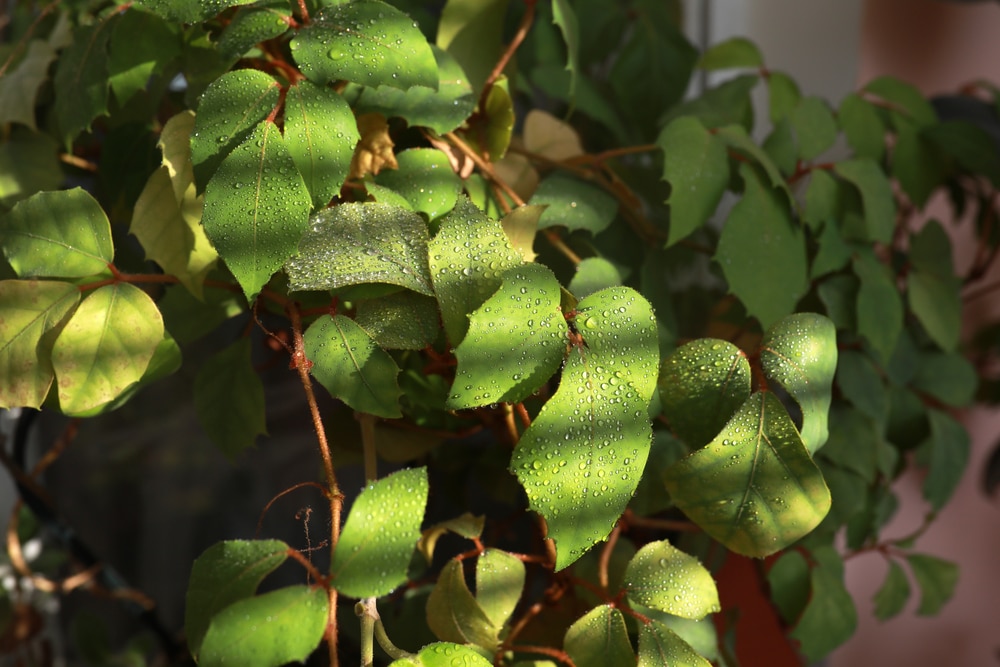
Grape Ivy looks lovely, it’s easy to grow, and the leaves will get quite a bit shinier as it matures. According to the ASPCA and the University of Vermont, it’s also non-toxic for cats and dogs, so this is a great hanging plant if you’ve got some pets in the household and you’re worried about them getting into your plants.
While vines grow to be up to 10 feet in length outdoors, it is rare for an indoor plant to exceed 5 feet, so this is a nice corner plant, and you’ll also get some fuzzy green flowers in the springtime.
African Violet potting mix is a good match for Grape Ivy and it like indirect medium-to-bright light. Water it weekly, but check the topsoil just to ensure that it’s dried out a bit first and let the water fully drain after each watering.
Christmas Cactus – Schlumbergera truncata
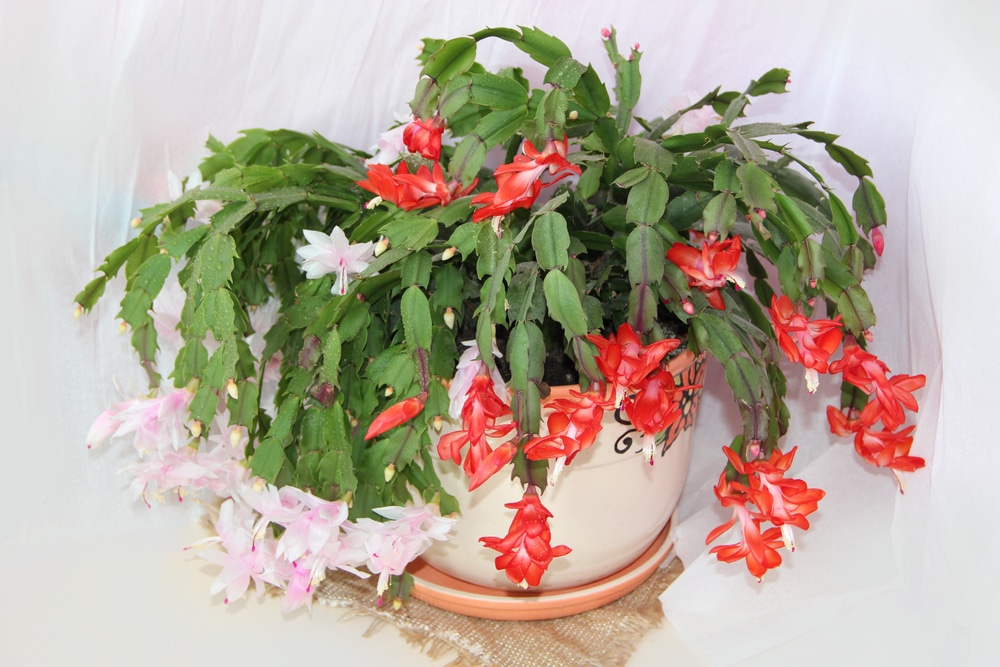
Christmas Cactus is a tough succulent that is quite beautiful to have at home. The spiky, green leaves of this plant will eventually grow down and out of the pot, but what you’ll love the most is from early to mid-winter when it flowers. Depending on the Christmas Cactus you select, those flowers might be pink, lilac, red, orange, white, or gold!
These are little guys, measuring 6 to 12 inches tall at full maturity, with a width of 12 to 24 inches.
The best soil mix for a Christmas Cactus is 1 part cactus mix, 1 part sand, and 1 part orchid mix. As far as sunlight, these plants like bright, indirect sunlight and lots of it – but there’s a caveat.
During blooming months, you want to make sure not to turn on the lights at night before flowers have arrived, as this messes with the plants blooming cycle. This might be easier if you put this plant somewhere secluded, such as a study.
Watering should be done every 2 to 3 weeks, but check the top 1/3 of the soil to make sure that it is dry first. A little water-soluble fertilizer every 2 weeks from spring to fall will also help to keep your plant healthy and increase the likelihood of blooming.
Sterling Silver – Scindapsus Treubii Moonlight
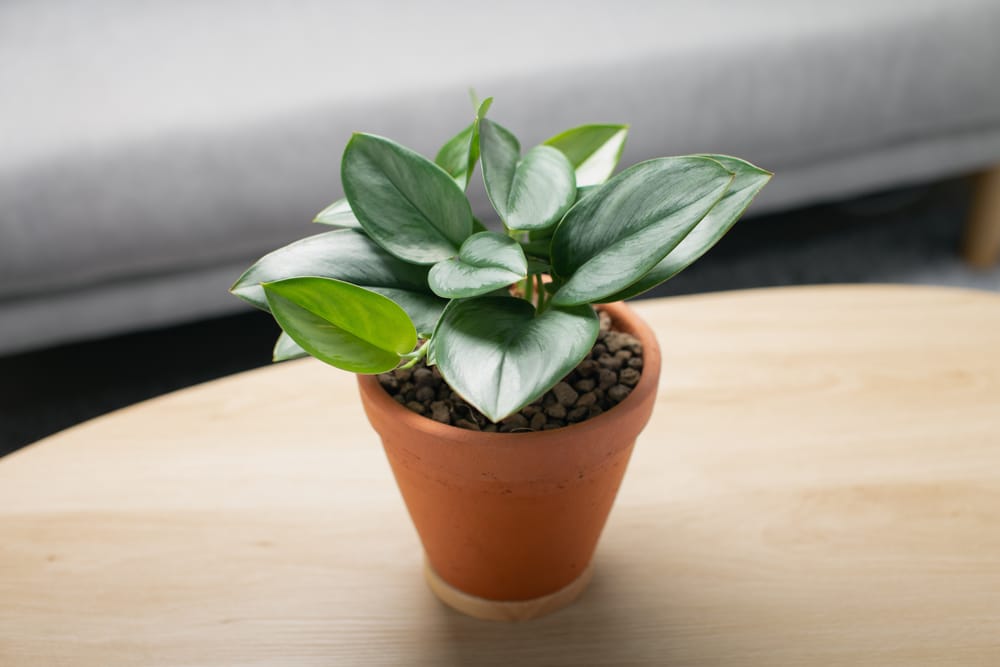
The Sterling Silver is a fantastic choice for a trellis or hanging basket in your home and it gets its name from its silver-frosted green leaves. It’s also a fast-growing plant and if you take care of it, then it can fill up a space quickly for you in an amazingly short time.
At full maturing, Sterling Silver can reach lengths of up to 8 feet and their leaves range from modest to gigantic, measuring in at 4 to 20 inches in length! If you want a real showpiece of a hanging plant, then Sterling Silver certainly qualifies.
Soil-wise, this is not a picky plant, and any succulent or cactus mix soil will do nicely for a home. Sterling Silver needs a lot of bright, indirect light, and you’ll need to water it about once a week. Just check the topsoil to ensure that the top 2 inches are dry, as this plant gets unhappy if you overwater it.
Polka Dot plant – Begonia Maculata
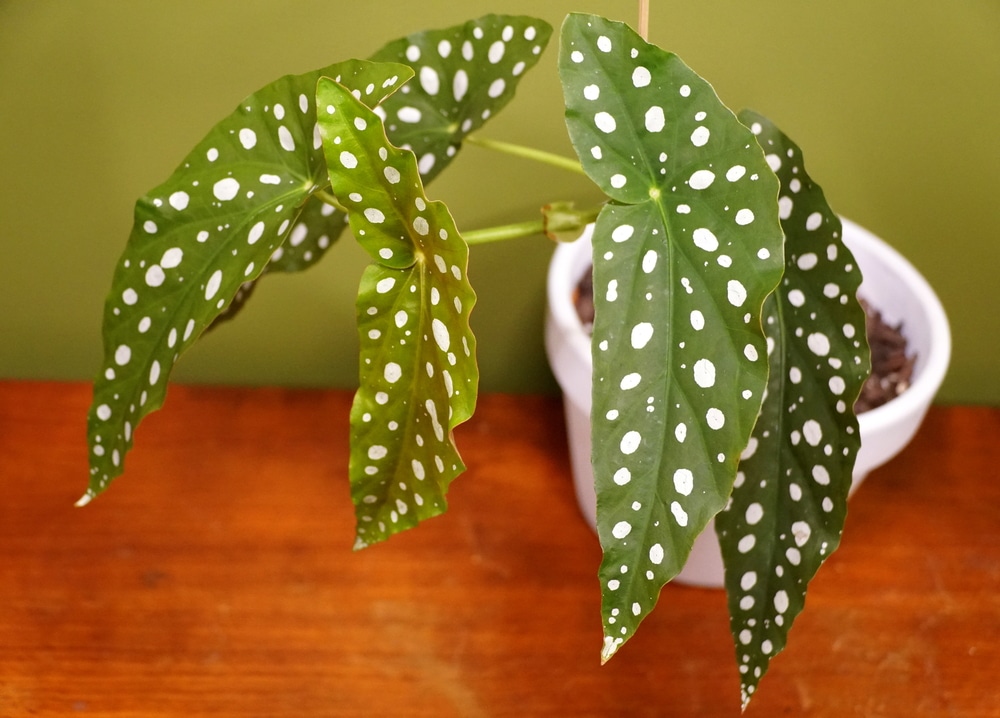
For a hanging plant with plenty of personality, you’d be hard put to beat the Begonia maculata, aka the Polka Dot plant. It’s got olive-green leaves, which are often red on the undersides, and on the top it does indeed have polka dots – in red, white, or pink!
You’ll be able to hang it but eventually you might be tempted to move it to its own table, as this plant will be about 4 feet when it matures. That’s a lot of polka dots leaves and that makes the Polka Dot plant one of those houseplants that you’ll never get tired of looking at.
Sandy loam soil is going to be the best fit for Polka Dot plant and bright, but indirect sunlight is recommended. As far as water requirements, once every 1 or 2 weeks during the winter is good but, in the summer, you should water it every 4 days. Just make sure that the top 2 inches of soil are dry before you do, as overwatering puts your plant at risk for root rot!
String of Beads – Senecio rowleyanus
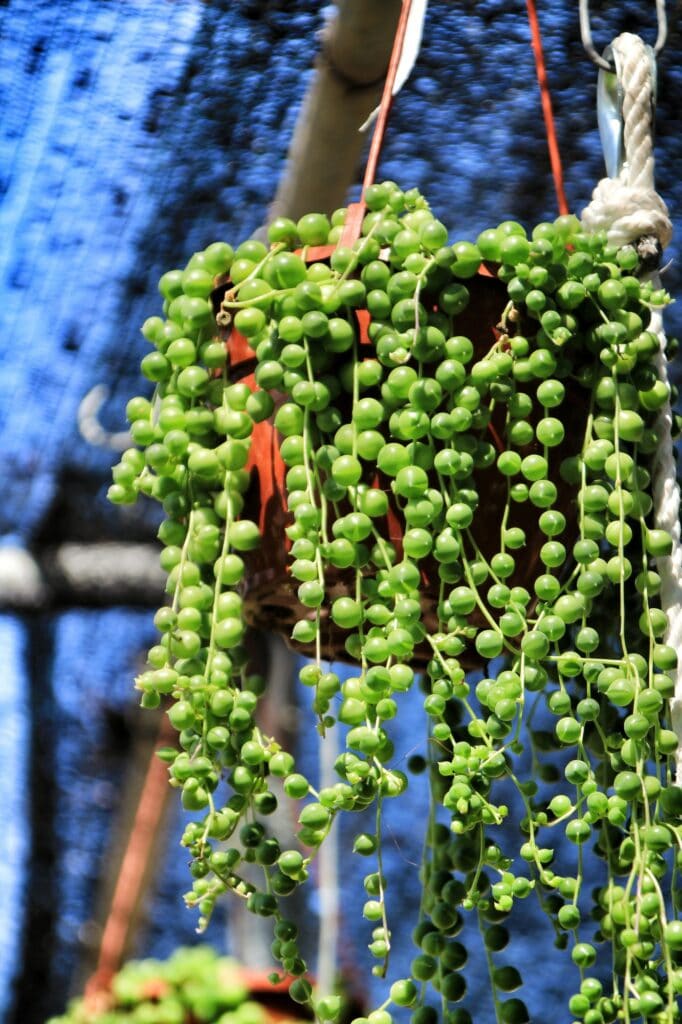
Also known as ‘String of Pearls’, the String of Beads is a rough and tumble succulent that sports leaves which look like peas on a string! This vine can be grown in the house and put in a hanging pot for maximum viewing pleasure and it will likely prompt a few curious questions. It’s pretty, odd, and definitely an interesting choice for spicing up your home.
At full maturity, this plant will be 1 – 2 feet tall and 1 – 2 feet long, so it doesn’t need a lot of space to make an interesting statement.
This plant likes sandy soil, so a cactus mix is going to be a great choice for housing your String of Beads. They do best with direct sunlight in the morning and indirect light the rest of the day, but bright, indirect light should do if moving it around is not going to be an option.
This plant only needs to be watered once every week or two, just check the top inch of soil to make sure that it’s dried out and if so, then water away!
Hindu Rope Plant – Hoya carnosa ‘Compacta’
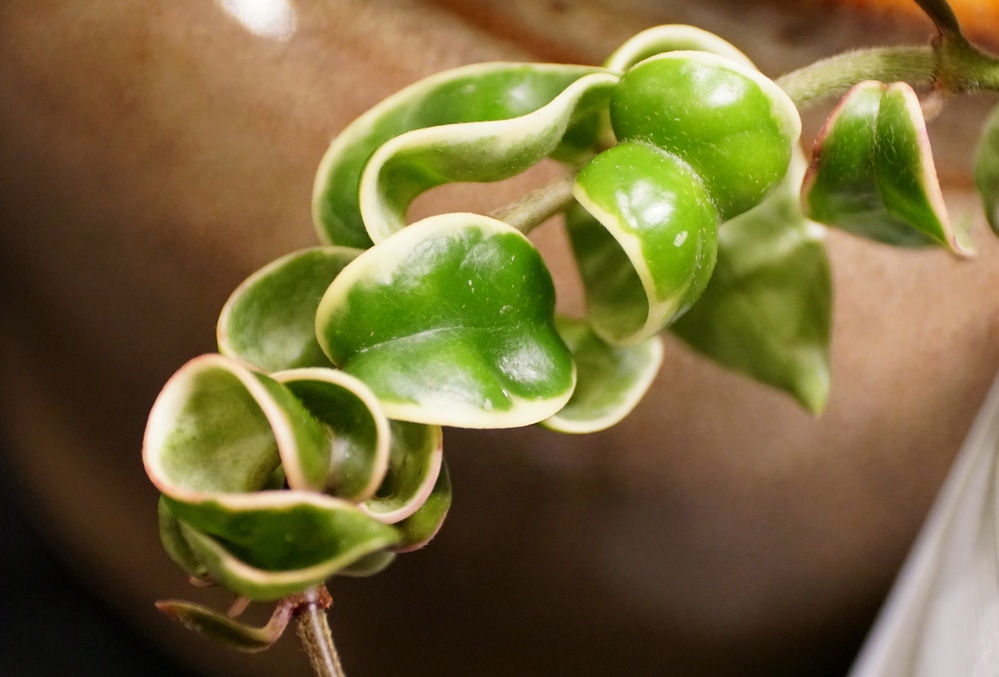
Hindu Rope plant is a great choice for hanging in the home. It’s drought resistant, so it’s easy to take care of, and the cream and green leaves of the plant start growing clusters of pink flowers for you in the spring that are not only lovely, but quite fragrant!
These vines can grow up to 20 feet long, so you’ll want to keep an eye on your plant and prune from time to time, but beyond this the care for this stunning semi-succulent is really quite minimal.
Regular potting soil is just fine for Hindu Rope plant and 6 hours a day of bright, but indirect sunlight, will keep your plant both colorful and happy. Watering is pretty low-maintenance too, with once a week from Spring to Summer and generally twice a week in the remaining seasons.
Just check the topsoil to make sure it’s dried out in the top 2 inches and if so, then you can water with confidence.
Bird’s Nest Fern – Asplenium nidus
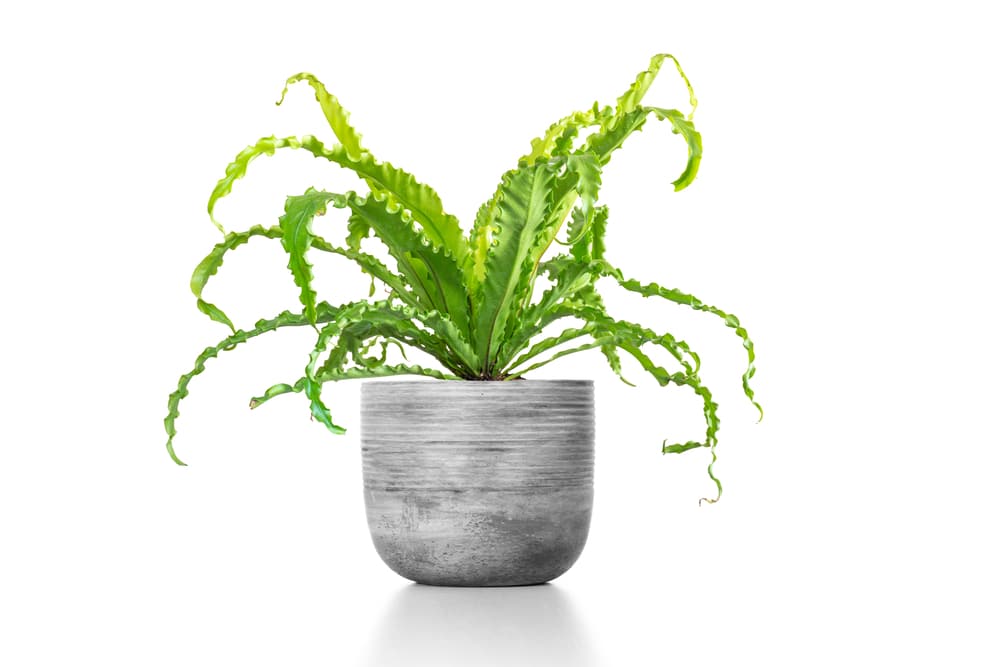
With waxy, crinkly green leaves growing upright, the Bird’s Nest Fern stands out quite a bit from your average hanging plant fare. It won’t always stand straight up, either, as the plant fronds will be just under 60 inches long at full maturity and up to 7.9 inches wide!
If you’d like a hanging plant that looks quite a bit like tropical banana leaves, then the Bird’s Nest Fern might be your next favorite hanging plant.
In the rainforest these plants normally grow in the crook of trees, so a peat-based potting soil is going to be the best medium for housing your Asplenium fern. They also don’t need as much sunlight as most of the plants on this list, doing best in medium to low levels of indirect light to mimic their natural environs beneath canopies of trees.
Watering should be done every 1 to 2 weeks, just make sure that the top half of the soil has dried out before watering and your plant should do just fine.
English Ivy – Hedera helix
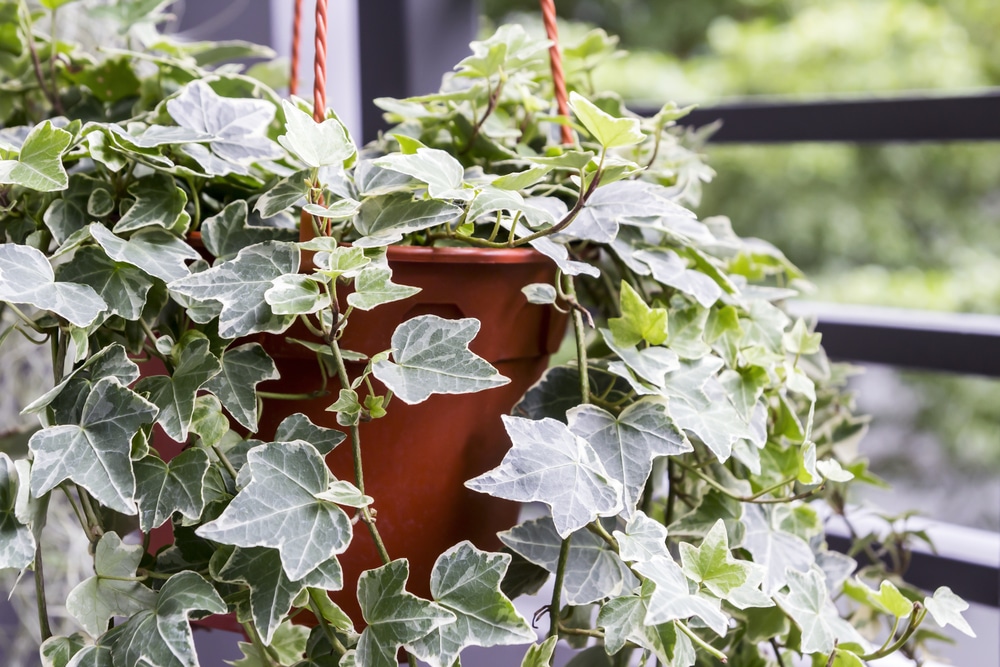
The common English Ivy is a favorite hanging plant for many. With its interestingly shaped light and dark green leaves and relatively low maintenance, it’s a great houseplant that will look good anywhere in the house.
English Ivy will need a bit of pruning, as it can grow to lengths of up to 50 feet long outdoors. The first 3 years that you own it, this plant will grow slowly, but after that you can expect it to grow as much as 8 or 9 feet every year. If you want a hanging houseplant that will fill its spot with green very quickly, then it’s really hard to beat English Ivy!
For English Ivy, add a little perlite to a peat-bead potting soil and this will be just about perfect. Bright, indirect sunlight is best but Ivy is seriously robust, and will grow in just about any condition – full sunlight, low sunlight… this stuff just endures!
Water it every 5 to 7 days, but check to make sure that the top 2 inches of soil are dry. Ivy doesn’t mind a little underwatering, but it gets cranky and will start dropping leaves if it gets too much. Just always check the soil first and you’ll get a good idea of its needs very quickly.
Prayer Plant – Maranta leuconeura
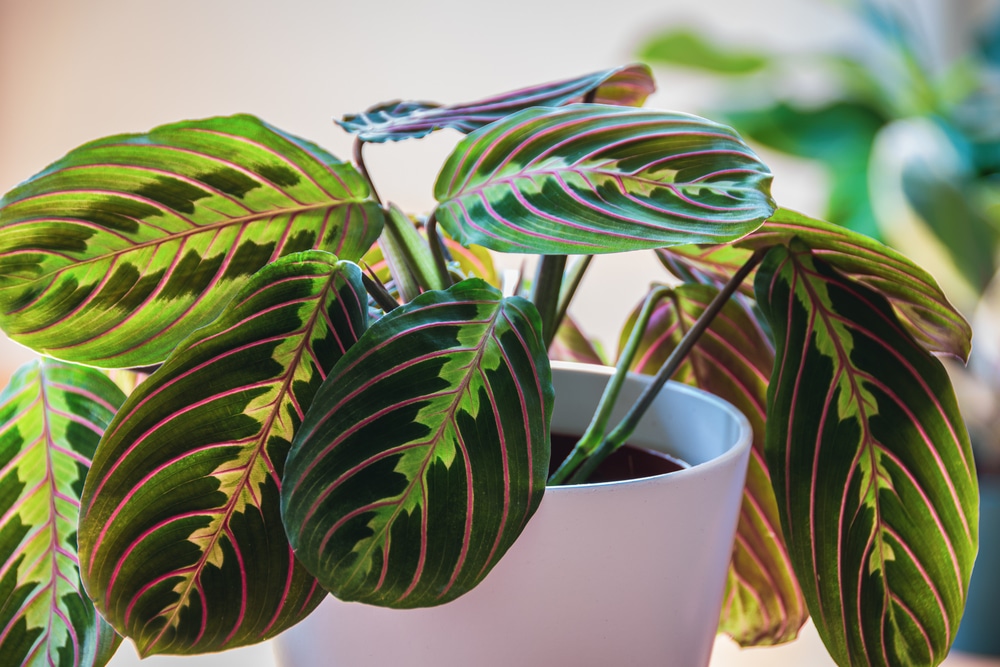
We’ve saved one of the neatest hanging plants for last. The Prayer Plant has beautiful, light green leaves with darker green patterns upon them, and every night these leaves will fold up like hands placed together in prayer.
They also don’t need much space at all. At full maturity, these animated plants will be about 10 to 12 inches tall and only 15 to 18 inches wide. They do like humidity, though, so you’ll want to hang it in a bathroom or near a humidifier for best results.
While regular potting soil will work, if you want some supercharged soil then mix up 2 parts of sphagnum peat, 1 part coarse sand, and 1 part loamy soil and your Prayer Plant will love it. Give it bright, indirect sunlight and water it once every 1 to 2 weeks or when the top half of the soil is fully dried out.
Some Final Words on Hanging Plants
We hope that you’ve enjoyed this little exploration into some of the wonders of Nature that are well-suited for bringing home to enjoy. Be sure to follow our care instructions carefully and avoid overwatering and you’ll be enjoying these plants for many years to come.
So, fill your house with life… the air will be cleaner, your house will be more colorful, and you’ll always look forward to coming home!


This is a great list of hanging plants which includes how to care for them. I will save the article for my next plant purchase! I have subscribed to your posts so a big thanks for your articles.